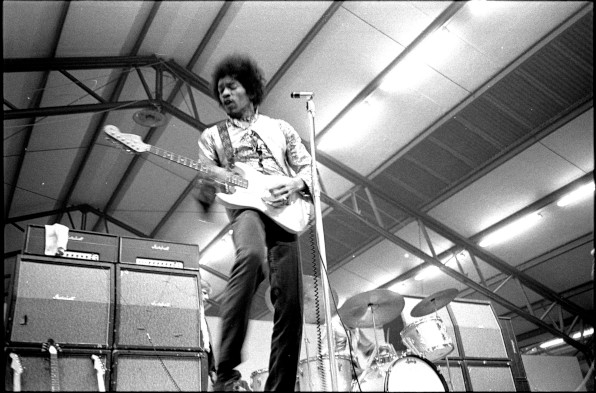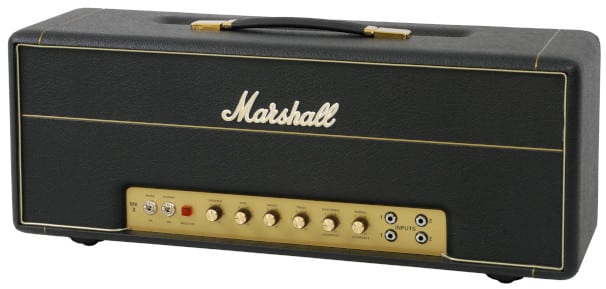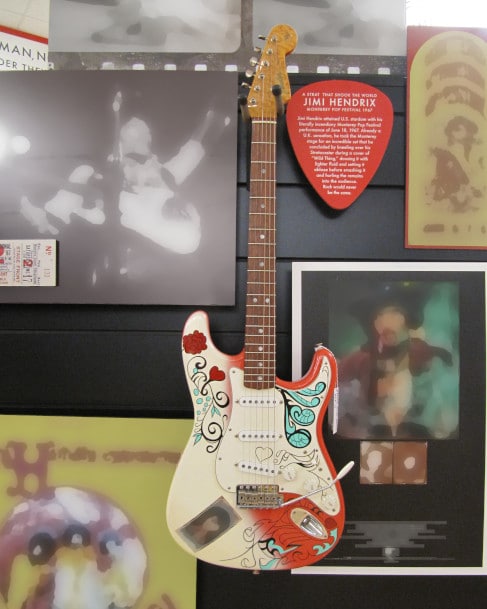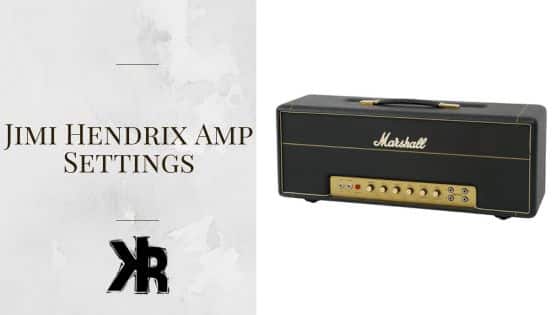Table of Contents
When it comes to capturing an iconic sound, the role of Jimi Hendrix amp settings cannot be underestimated. The specific settings on an amplifier play a crucial role in shaping the guitar tone and achieving that Hendrix sound.
Hendrix was known for his groundbreaking use of amplifiers and his ability to manipulate their settings to create unique and expressive sounds.
To get into the realm of Hendrix’s sound, it is essential to explore the amplifiers he favored. Hendrix was known to use a variety of amps throughout his career, including the Marshall Super Lead 100-watt head, Fender Bassman, and Supro Thunderbolt. Each of these amplifiers had its own unique qualities, contributing to the diverse sonic palette that Hendrix possessed.
Familiarizing oneself with the amp settings used by Hendrix on his famous songs is also beneficial. Tracks like “Purple Haze,” “Voodoo Child (Slight Return),” and “All Along the Watchtower” are perfect examples to study. Breaking down the amp settings on these iconic tracks sheds light on the specific techniques and approaches Hendrix employed to create his legendary sound.
This Killer Rig article is designed to help guitarists personalize and recreate the Hendrix sound. By tweaking settings, exploring pedal options, and adding a personal touch, you can also incorporate your unique artistic expression.
The Impact of Amps in Shaping Guitar Tone
The amp significantly shapes guitar tone. It acts as the link between the guitarist’s technique and the final sound. The choice of amp can greatly affect the tone. Tube and solid-state amps produce different sounds.
Tube amps have warm and natural tones, while solid-state models offer cleaner and more modern sounds.
In addition, the amp settings are crucial for shaping the guitar tone. Adjusting volume and gain settings determines the level of distortion or overdrive, which affects the sound’s character.
Equalization settings, like bass, mid, and treble controls, allow for fine-tuning the frequency response of the guitar. Reverb and effects settings add depth and ambiance to the tone, enhancing the overall sonic experience.
Understanding the amp’s impact on guitar tone is crucial for musicians seeking to recreate the sounds of legends like Jimi Hendrix. The tube amp was his go to because solid state options just didn’t offer the same quality.
But this is also part of the magic in his tone. The cranked up tube amp is so dynamic that it adds a special flavor to the sound. Something that a solid state amp struggles to do. And while it’s not impossible to obtain, a great degree of experimentation is required with some models.

What is the Hendrix Sound?
The Hendrix sound is a term often used to describe the groundbreaking and distinctive guitar tone that Jimi achieved throughout his career.
It’s a sound that has left an indelible mark on the world of music and continues to inspire guitarists to this day. Let’s explore the key elements that define the Hendrix sound:
1. Psychedelic Blues Fusion
Hendrix’s sound was a fusion of blues, rock, and psychedelic music. He took traditional blues licks and infused them with modern rock energy and experimental psychedelic flair. This blend created a unique musical landscape that was both rooted in tradition and ahead of its time.
2. Innovative Use of Effects
Hendrix was a pioneer in using guitar effects like wah-wah, fuzz, and Uni-Vibe. His creative use of these effects added layers of texture and complexity to his sound. The famous “wah” sound in “Voodoo Child” is a prime example of his mastery over these tools.
3. Controlled Feedback and Distortion
He had an uncanny ability to control feedback and use it musically. By pushing his amplifiers to their limits, he could create a controlled chaos that added an aggressive edge to his sound. His use of distortion was not just about loudness; it was about sculpting a sonic experience.
4. Expressive Playing Style
Hendrix’s playing was highly expressive and emotive. He could make his guitar cry, sing, scream, or whisper, often within the same song. His use of bends, vibrato, and legato techniques gave his playing a vocal-like quality that connected with listeners on an emotional level.
5. Unconventional Techniques
From playing with his teeth to behind his back, Hendrix’s stage presence and unconventional techniques were as much a part of his sound as his tone. These theatrics were not just for show; they were an integral part of his musical expression.
6. Tuning and Guitar Setup
Hendrix often played a right-handed guitar flipped upside down and restrung for a left-handed player. He also experimented with alternate tunings. These unique aspects of his setup contributed to a sound that was uniquely his own.
The Hendrix sound is not just a tone or a set of techniques; it’s an approach to the guitar that broke all the rules and redefined what was possible. It’s a sound that resonates with freedom, creativity, and innovation. It’s a sound that, decades later, still feels fresh and continues to inspire.
Jimi Hendrix’s Favorite Amplifiers
Jimi Hendrix had a preference for certain amplifiers that greatly contributed to the unique tone of his guitar. Allow me to provide you with an overview of the specific amplifiers he favored:
Marshall JTM45
The Marshall JTM45 was known for its warm and rich tone. Hendrix loved this amp for its ability to provide a smooth overdrive that was perfect for blues-inspired solos. Its 45-watt power output allowed for a controlled yet powerful sound, making it a staple in his early performances.
Marshall Super Lead 100

The Super Lead 100 was one of Hendrix’s go-to amplifiers for live performances. With a whopping 100 watts, this amp could deliver a loud and aggressive sound that cut through the mix.
Its bright and biting tone was perfect for Hendrix’s psychedelic rock style, and he often paired it with a 4×12 cabinet for a full and immersive sound.
Sunn 100S
The Sunn 100S was favored by Hendrix for its versatility and unique tonal characteristics. With 100 watts of power, it provided a clean platform for Hendrix to experiment with various effects. Its robust construction and reliable performance made it a trusted companion on the road.
Fender Twin Reverb
The Fender Twin Reverb was cherished by Hendrix for its crystal-clear clean tones and lush reverb. With 85 watts, it offered plenty of headroom for clean playing, yet could be pushed into a sweet, harmonic distortion.
Hendrix often used this amp in the studio, where its nuanced sound could be captured in all its glory.
These amplifiers laid the foundation for the exceptional sound that Hendrix was known for. In his pursuit of diverse tones, he utilized different models, skillfully leveraging the characteristic features of each amplifier.
Fun Fact: Jimi Hendrix fearlessly pushed his amplifiers to their absolute limits, resulting in a distorted and immensely powerful sound that completely revolutionized the landscape of electric guitar playing.
Understanding Jimi Hendrix Amp Settings
Get ready to rock with Jimi Hendrix’s iconic tone! So crank up your amp, grab your guitar, and let’s uncover the magic behind his unforgettable sound.
Volume and Gain
When recreating Jimi Hendrix’s sound, the volume and gain settings on your amplifier are crucial. Here are some key points to consider:
- Start with the volume: Jimi Hendrix played with high volume, but find the right balance. Set your volume at a moderate level and adjust based on preference and environment.
- Tweak the gain: Jimi Hendrix used decent gain settings for his signature distorted sound. Gradually increase gain while playing to find the sweet spot for your style. Too much gain can create excessive noise and muddiness.
- Find the right balance: Strike a balance between volume and gain to achieve the desired tone. Adjust the volume as you increase gain to maintain clarity and avoid excessive distortion.
- Listen and adjust: Trust your ears and make adjustments as needed. Experiment with different combinations of volume and gain settings to match Jimi Hendrix’s sound.
By exploring volume and gain settings on your amplifier, you can unlock Jimi Hendrix’s iconic sound and add your own personal touch to his style. Just remember that most of his distortion came from the power section.
In order to obtain the same effect, you would need a very loud amp. So try and recreate the distortion with the preamp or a pedal instead.
Equalization
| Equalization Settings | Effect | Impact on Sound |
|---|---|---|
| Bass | Boosts or cuts low-frequency range | Provides warmth and depth, enhances low-end response |
| Middle | Boosts or cuts mid-frequency range | Affects presence and character, adds clarity and definition |
| Treble | Boosts or cuts high-frequency range | Increases or reduces brightness and shimmer, enhances high-end response |
Equalization settings play a crucial role in shaping Jimi Hendrix’s guitar tone. Adjusting the bass, middle, and treble frequencies allows you to customize the sound to achieve the desired effect.
Changing the bass settings adds warmth and depth to the tone, giving it a rich and powerful low-end response. Increasing the middle frequencies enhances the presence and character of the sound, providing clarity and definition.
Manipulating the treble frequencies allows you to control the brightness and shimmer, adding a dynamic edge to the guitar tone.
To recreate Jimi Hendrix’s sound, experiment with different equalization settings on your amp. Pay attention to the impact each adjustment has on the sound and find the right balance that captures the essence of his iconic tone.
Remember, the equalization settings can vary depending on the specific amp and equipment you are using, so don’t be afraid to tweak and fine-tune until you achieve the desired result.
By mastering the art of equalization settings, you can unlock the secrets of Jimi Hendrix’s tone and take your guitar playing to a new level.
Reverb and Effects
Reverb and effects are a big part of the Hendrix sound. But it’s easy to get carried away with effects, and so here are a few tips on how you can apply them to your sound.
- Room size: Experiment with reverb based on room size. Larger rooms may require more reverb for a spacious sound.
- Reverb type: Jimi Hendrix used spring reverb for a vintage and warm tone. Try different reverb pedals or amp settings to find your desired sound.
- Reverb level: Adjust reverb to achieve the right balance. Too much reverb can muddy the sound, while too little can make it dry. Find the sweet spot for your style.
- Delay/Echo: Use delay settings to add depth and dimension to your playing, contributing to Hendrix’s sound.
- Modulation effects: Incorporate chorus or phaser effects subtly for a psychedelic touch to your tone.
- Order of effects: Experiment with different pedal arrangements to find the best combination for your playing style.
Remember, while these settings can help you achieve a similar sound, it’s important to experiment and develop your own unique style. Use Jimi Hendrix’s approach as inspiration and make it your own.
Not sure what amp settings actually do? Check out my guide to amp controls and settings to get up to speed!
Famous Songs and the Amp Settings Used by Jimi Hendrix
Exploring iconic tracks helps us understand Jimi Hendrix’s specific settings for his signature sound.
Purple Haze Amp Settings
In the classic song “Purple Haze,” Hendrix used a Marshall Super Lead 1959 amp with the volume set at around 7, the gain at 8, and adjusted the equalization settings to emphasize the midrange frequencies. You could benefit from a mid-gain amplifier with these settings:
- Gain: 7
- Treble: 5
- Mids: 6
- Bass: 5
- Volume: 5
Voodoo Child Amp Settings
In “Voodoo Child,” Hendrix used a Fender Stratocaster plugged into a Marshall Super Lead 100-watt amp. He set the volume to 9, gain around 7, and dialed in a balanced equalization with boosted mids and slightly rolled-off highs.
You won’t need ultra volume settings like this, and I’m sure your neighbors wouldn’t appreciate it. So find a mid-powered amplifier and use these settings instead:
- Gain: 8
- Treble: 6
- Mids: 6
- Bass: 6
- Volume: 5
All Along The Watchtower Amp Settings
On “All Along the Watchtower,” Hendrix again used a Marshall Super Lead 100-watt amp, but this time with the volume set quite low at around 3 or 4. He increased the gain to 7 and used a combination of boosted mids and treble, while rolling off some of the bass frequencies.
There isn’t a great deal of distortion or break up on this track, so you can go ahead and try these settings:
- Gain: 5
- Treble: 6
- Mids: 6
- Bass: 5
- Volume: 5
Foxey Lady Amp Settings
For “Foxey Lady,” Hendrix favored a combination of a Fender Showman and a Marshall Super Lead 100-watt amp. He set the volume around 6, gain at 7, and boosted the midrange frequencies for a punchy tone.
To get the same type of pushed and somewhat fuzzy tone, use these settings:
- Gain: 7
- Treble: 6
- Mids: 7
- Bass: 6
- Volume: 6
What Guitars Do You Need for the Hendrix Sound?
Jimi Hendrix’s guitar playing was not only about his unique techniques and amplifier settings, but also about the specific guitars he used. These guitars played a crucial role in shaping his iconic sound. Here’s a look at the main guitars you would need to recreate the Hendrix sound:
Fender Stratocaster
The Stratocaster was perhaps the most synonymous with Hendrix’s sound. Its three single-coil pickups provided a bright and cutting tone that Hendrix could manipulate with his playing style.
The guitar’s contoured body and whammy bar allowed for the expressive bends and vibrato that were key to his sound.

Gibson Flying V
Hendrix loved the Flying V for its radical design and powerful humbucking pickups. It provided a thicker, more aggressive tone compared to the Stratocaster, and its unique shape allowed for easy access to higher frets.
Gibson SG Custom
The SG Custom offered a rich and warm tone with its mahogany body and three humbucking pickups. Hendrix used it for its versatility and ability to produce both clean and distorted tones with ease.
Fender Jazzmaster
Though not as commonly associated with Hendrix as the Stratocaster, the Jazzmaster’s unique circuitry and pickups allowed for a wide range of tones. Its floating tremolo system also contributed to Hendrix’s experimental sound.
Jimi Hendrix Tone Tips
Struggling to nail down the legendary Hendrix sound? You’re not alone. Jimi Hendrix’s tone is one of the most sought-after and complex in the world of guitar. Here are some common troubleshooting tips to help you get closer to that iconic sound:
- Experiment with Fuzz and Wah Pedals:
- Hendrix was known for his extensive use of fuzz and wah effects. If your amplifier isn’t capturing that psychedelic sound, consider investing in a fuzz or wah pedal. Models like the Fuzz Face and Cry Baby Wah were favorites of Hendrix.
- Adjust Your EQ Settings:
- If your tone is too bright or thin, try lowering the treble and boosting the bass. Hendrix often played with a warm, full-bodied tone, so don’t be afraid to experiment with your EQ settings.
- Utilize Your Guitar’s Tone Control:
- Hendrix was a master of using his guitar’s tone control to shape his sound. If things are sounding too bright, roll off the tone knob to warm it up.
- Avoid Muddiness:
- If your sound is too thick and lacks clarity, try reducing the bass and adding more mids and treble. Hendrix’s sound was rich but never muddy.
- Explore Different Pickup Positions:
- Hendrix often switched between pickup positions to achieve different tonal characteristics. Experiment with both the neck and bridge pickups to find the right balance of warmth and bite.
- Consider Different Guitars:
- While Hendrix is most associated with the Stratocaster, he also played other guitars. If you have access to different instruments, try them out to see how they affect your tone.
- Try Different String Gauges:
- Hendrix used a variety of string gauges to achieve his sound. Heavier strings can add thickness and sustain, while lighter offerings may provide more brightness and responsiveness.
- Emulate Hendrix’s Playing Techniques:
- Beyond gear and settings, Hendrix’s playing techniques were integral to his sound. Work on emulating his use of thumb-over fretting, double stops, and expressive bends.
- Consider the Amplifier:
- Hendrix used specific amplifiers like the Marshall Super Lead 100. If you’re serious about achieving his tone, researching and investing in similar amplifiers or amp simulators can make a significant difference.
Affordable Jimi Hendrix Rig
So, we have touched on the gear that Hendrix would have played to get his sound. But, some of it is either no longer available, or super expensive to obtain! If you’re a guitarist on a budget, I’ve put together a list of gear that is affordable that you can get today!
This will provide you with some good quality gear at a super great price. And best of all, it will be more than possible to get yourself some Hendrix tone right out of the box!
Conclusion
In the electrifying world of Jimi Hendrix, the magic lies not just in the fingers but also in the intricate dance between guitar, amp, and effects. This guide has offered a glimpse into the legendary musician’s sound, unraveling the mystery behind his iconic tone.
From the specific gear to the nuanced amp settings, we’ve explored the essential elements that can help you channel your inner Hendrix.
But remember, the equipment is just the starting point. Hendrix’s sound was as much about his soul and creativity as it was about the knobs and dials. So, grab your guitar, tweak those settings, and let your creativity flow. Experiment, explore, and find your unique voice, just as Jimi did.
Frequently Asked Questions
Can I achieve Jimi Hendrix’s tone with a Boss DS-1 distortion pedal?
Yes, a Boss DS-1 distortion pedal can be used to mimic Hendrix’s classic fuzz tone. Turn up the gain knob on your amp to around seven or eight for saturated distortion. Adjust the EQ settings to have a heavy distortion with classic rock tonality.
What other pedals can I use to replicate Jimi Hendrix’s sound?
Hendrix primarily used the Dunlop Dallas Arbiter Fuzz Face and the Vox V846 Wah. These pedals, combined with the right amp settings, will help you achieve an accurate Hendrix sound.
How important is having a high-quality amp?
Having a high-quality amp is essential for achieving a great sound. The amp plays a crucial role in shaping the tone. Hendrix used a Marshall Plexi amp, known for its iconic and influential sound in rock and blues music. But today we have many great options to choose from.

